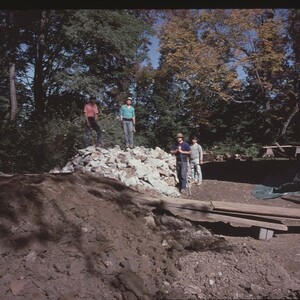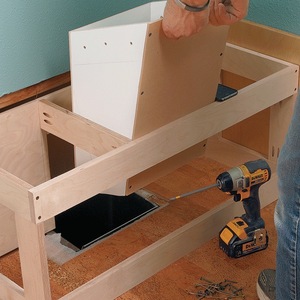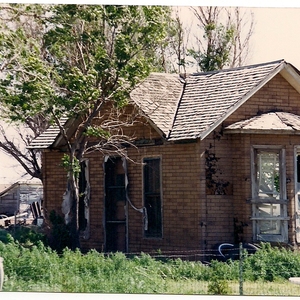vapor barier when drywalling ceiling
Hi. I am a finish carpenter doing my first drywall job. My own house. We gutted the kitchen and moved walls leaving a ceiling in need of repair. The original drywall ceiling and 2 ml vapor barier is still up. The vapor barier is broken in many places as we moved lights and walls so I wanted to redo it. The mudder i hired to finish the drywall sugested that I leave up the old drywall and install a new vapor barier before i install the new drywall to the ceiling. Is this ok.Tthanks for any input.


















Replies
No, Not OK.
No, what you propose is NOT 'OK' and could actually be a building code violation.
What you propose is in fact creating a 'double vapor barrier' which can trap moisture between the two membranes.
Talk to you local code official before proceeding.
Not a problem...
It would result in two vapor barriers, but I would not consider that to be the "double vapor barrier" that is to be avoided because of its potential to cause moisture retention problems. In this case the two barriers are only 1/2" apart, so they will both be fully on the warm side of the insulation. The old vapor barrier will not condense any vapor that gets past the new one. And the old barrier is full of holes, so it can ventilate. In any case, I don't see how this plan to add a new barrier while leaving the old one can create any problem.
Like I said, some folks would holler.
How about using a vapor barrier primer like Benjamin Moore Super Spec Latex Vapor Barrier Primer Sealer 260 which has a Water Vapor Permeance of .5 perms?I like this product because the vapor barrier is complete and is not penetrated with screws or staples. Additionally sealing around any penetrations like like can lights would be an important detail.
It's a "Double Vapor Barrier" and a "Problem"
Don't know what part of energy and building codes some who are posting here do not understand what double vapor barriers can do... but a vapor barrier on both the warm-in-winter side and warm-in-summer sides creates a moisture condensating problem between both vapor bariier that can:
1...Create MOLD
2...Create MOISTURE that can rust FASTENERS
3...Deteriorate the DRYWALL
What the original poster has suggested needs to be avoided at all costs....
And those who have disagreed with me must be IGNORED at all costs!
Sheesh!
To my recollection the OP hasn't suggested two VBs on opposite sides of the insulation. He was discussing two VBs half an inch apart. Not a problem.
If he was putting the vapor barrier below & above the insulation that would be an issue. He can put 5 vapor barriers next to each other and all it does is increas the permeance rating. The real question is why does he think he needs one at all. if the r-value about that is above r-38 he should not even need one. You may consider doing nothing if your raising the r-value.
Question:
Why do you conclude that no vapor barrier is needed if the R-value is high enough?
enough ins no vapor barrier
I have been told that after r-38 on the ceiling that no vapor will make it thru so not needed. If thats wrong let me know.
It depends on the permeability of the insulation
Close cell foam is impermeable enough to act as a suitable vapor retarder. So as long as its R-value is high enough to prevent the room-facing surface from cooling down to the dew point of the moisture in the room, no added vapor barrier would be needed.
Fiberglass insulation is highly permeable, so water vapor will move right through it, encountering progressively cooler temperatures as it goes. If it encounters a cool enough temperature to reach the dew point somewhere along the way, it will condense there and wet the fiberglass. So it does not make any difference how high the total R-value of the insulation layer is. You would need a vapor barrier of some type either at the room side of the fiberglass layer, or it could even be set into the layer some distance. It just has to be positioned to stop the outward vapor migration before it can reach a temperature cool enough to condense the vapor.
I have heard claims the cellulose can be installed dense enough to prevent vapor from passing through it, and therefore, can be installed without a vapor barrier. In other words, it is claimed that dense cellulose is impermeable enough to act as its own vapor barrier just like closed cell foam is. I do not know if that claim is true, but I am skeptical of it.
Bear in mind that the effectiveness of a vapor retarder (barrier if this is a poly sheet) is a simple matter of area. If only 2% of the ceiling area vapor retarder has been compromised, the whole ceiling vapor retarder is still 98% effective. Further, the application of latex paint over the whole ceiling reduces the permeability of the areas with torn VR to the point where no significant water vapor diffusion will occur at those areas anyway. Finally, if the space above the ceiling is a properly vented attic (ridge, soffit venting), no vapor barrier is needed anyway, as any tiny amounts of water vapor diffusing through the ceiling assembly is vented to the outside quickly. Bottom line: no further vapor retarder film need be applied, as the ceiling already has a highly effective one in place. However, assuming that 2 mil VR is poly and the attic is vented, the OP shouldn't run the A/C inside any colder in summer than the outside air dew point, something not usually done anyway.
Now, aside from the vapor diffusion retarder issue, there must be a good air barrier layer, to prevent convective flow (leaks) of inside air into the attic. Presumably the new sheetrock will be installed correctly, with seams taped and mudded, and light fixtures up there will be sealed to the sheetrock (and can lights enclosed and insulated in the attic).
One more vote in favor of your plan. You will essentially have just one vapor barrier because they are so close toghether, so that they both will see the same temperature.
However, for simplicity's sake, I would go with VB paint on the the new ceiling.